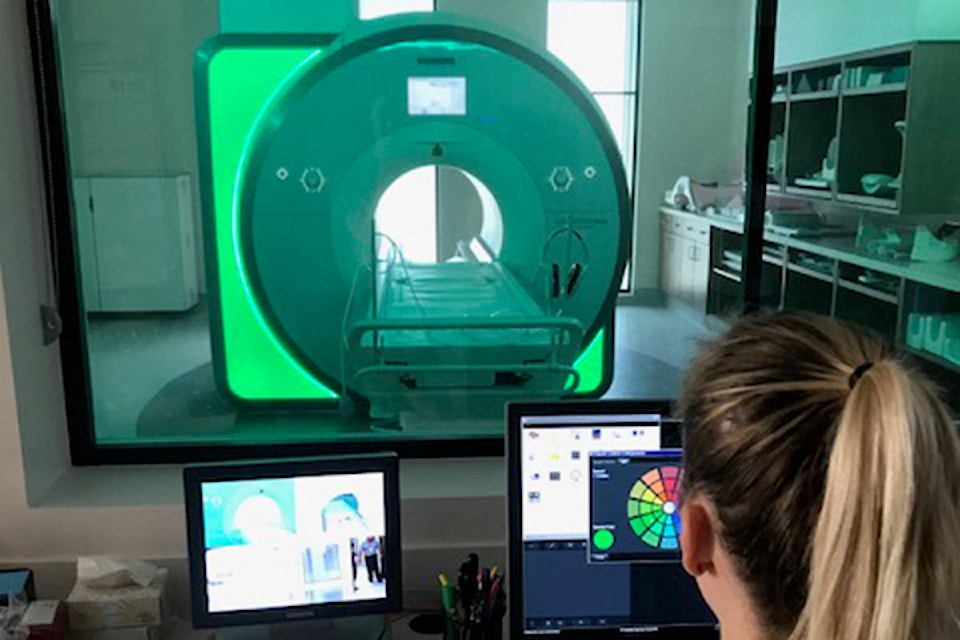A new piece of diagnostic equipment is now fully operational at the East Kootenay Regional Hospital.
The permanent Magnetic Resonance Imaging (MRI) unit officially began running tests for patients on June 11, and negates the need for a mobile MRI unit that had previously been in use by the EKRH.
“First of all, it’s exciting for Cranbrook,” said Adrian Dix, the Minister of Health, in an interview with the Cranbrook Townsman. “We just launched our B.C. surgical and diagnostic imaging strategy, so we’re increasing the number of MRIs by 20 per cent across the province and reducing wait times everywhere.
“…This is a big change, this is designed to reduce wait times and give people better access in the public system. And having a permanent machine in Cranbrook makes a big difference.”
The new permanent unit will double the previous capacity, rising to 3,000 annual exams as opposed to 1,300 in years past.
“That just makes a big difference, and people in Cranbrook who did a lot of work on this deserve credit as well,” Dix said, “because they are our partners on the capital side, but the key — in addition to that — is the operating support we’re giving to the MRI there, which is significant and will make a big difference.”
BREAKING: Permanent MRI unit now operational at East Kootenay Regional Hospital, which is expected to double capacity from 1,300 to 3,000 annual exams. pic.twitter.com/0Ggml31eLc
— CranbrookTownsman (@CranTownsman) June 15, 2018
MRI diagnostics used to be accessed through a mobile unit that was in Cranbrook for one week out of every four weeks. With the permanent MRI in place now, a 200 square metre space on the east side of the EKRH facility, the mobile unit will be free to travel to other areas that need MRI diagnostics such as Trail and Penticton.
“The shared mobile MRI can spend more time in those communities and reduce wait times there as well, so this has that effect as well, which is really positive,” Dix added, who noted that a permanent MRI has just been approved for Penticton as well.
“For the West Kootenay region, that’s going to have more benefits in all three communities.”
Announced, two years ago, the project broke ground last fall with a price tag of $5.65 million that included a number of funding partnerships.
Contributions were made by the Province/Interior Health ($2.21 million); Kootenay East Regional Hospital District ($2.14 million); East Kootenay Foundation for Health ($650,000 – which included a $100,000 contribution from the Kimberley Health Care Auxiliary, $50,000 from the Invermere Health Care Auxiliary, $25,000 from the Elk Valley Foundation, and $100,000 from the Fostering the Future Foundation); and Cranbrook Health Care Auxiliary ($650,000)
READ: Construction underway for MRI Unit
“Our Board is committed to supporting projects that have a direct impact on patient care in this region, and we are proud to be funding partners on this vital new service,” says KERHD Board Chair Dean McKerracher. “We would like to thank the Ministry of Health, Interior Health and all the other funders who’ve joined together to make this project a reality.”
The East Kootenay Foundation for Health mobilized behind a successful $650,000 fundraising campaign.
“Over the past number of years we have received countless questions about when our region would get a permanent MRI. Supporting the MRI project was a no-brainer for the East Kootenay Foundation for Health, as it will greatly improve health care in our region,” says Wes Rogers, EKFH board chair. “Thanks to the excitement about this campaign and the generosity of our donors, we reached our $650,000 goal in just five months.”
That campaign included lots of support from local and regional health care auxiliaries.
“Cranbrook Health Care Auxiliary’s entire membership was in full support of contributing toward the MRI installation from the moment we learned that it was possible for our regional hospital,” said Bonnie Close, past president. “The members worked hard to raise funds and they appreciate all the contributions received towards this special project.”
The MRI uses magnetic field and radio waves to produce detailed pictures of the body’s organs and structures, which helps diagnose a number of medical conditions, including abnormalities of the brain, as well as tumors, cysts and soft-tissue injuries in other parts of the body.
MRI diagnostics used to be accessed through a mobile unit that was in Cranbrook for one week out of every four weeks. With the permanent MRI in place now, a 200 square metre space on the east side of the EKRH facility, the mobile unit will be free to travel to other areas that need MRI diagnostics such as Trail and Penticton.
TA Rendek and Associates Ltd. served as the general contractor who oversaw the construction of the new diagnostic space, which is located right beside the Intensive Care Unit.
